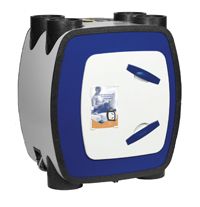Derek Guy, general manager of Itho Ventilation UK, offers some solutions as to how the increasingly challenging targets set by the government can be met using continuous ventilation.
There is now an overwhelming body of scientific evidence showing that climate change is a serious and urgent issue. In 2004, more than a quarter of the UK's carbon dioxide emissions - a major cause of climate change - came from the energy we use to heat, light and run our homes.
By 2016 the Government has stated that all new build homes must be zero carbon and already we are seeing countless developments within legislation to help point the industry in the right direction.
The raised standards of Part L of the Building Regulations (England and Wales), the introduction of the Code for Sustainable Homes and the guidelines set by the Energy Saving Trust all promote the benefits of airtight homes in the quest to reduce energy wastage, but it is important to understand the repercussions of this energy saving method before efforts to seal-up dwellings are undertaken.
Whilst building an airtight home dramatically reduces heat loss from a property thus helping energy consumption levels to remain low, without a continuous flow of fresh air into the property the internal atmosphere will become stale and full of contaminants which, if not removed, will cause countless problems with condensation, mould growth and aggravated health problems for the occupants.
Traditional forms of ventilation will not meet our future needs. Standard extractor fans cannot offer the energy efficiency performance required, while opening windows causes expensively generated heat to escape and lets pollution and, often, unacceptable noise in. This means there will be an increased use of continuous ventilation.
Climate change from CO
2 emissions is no doubt responsible for global warming.
By reducing the demand for energy and thus CO
2, Itho is developing a future of energy efficient ventilation innovations.

Itho HRU ECO 4 unit
The SAP Q eligible HRU ECO 4 MVHR whole-house ventilation system from Itho is one of the most energy efficient systems on the market. Offering a heat recovery of up to 91%, the unit transfers heat from the extracted contaminated air and fuses it into the incoming fresh air in order to maintain optimum temperatures.
Suitable for use in residential buildings, new builds, high and low rise buildings and renovations (where improvements to air tightness have been made), the triangular formation of the synthetic heat exchanger offers maximum surface area for heat to be transferred and this combined with its quiet energy saving DC motor, makes for an incredibly efficient system.
Continuous running fans
While the words 'continuous running' and 'energy saving' are rarely used in the same sentence, continuously running fans can now be more efficient than intermittent fans.
They allow a continuous flow of fresh air to circulate throughout the dwelling, drawing and expelling the contaminated, wet air from the areas that need it the most; the kitchen/utility, washrooms and bathrooms.
The running costs of such a system are so low, that, with the benefit of reduced fuel bills, the occupant is financially better off. As an example, to meet current building regulations, in a two storey building with a habitable floor area of 88.2 m
2 and kitchen plus three additional wet rooms (utility, bathroom and WC), the system needs to extract at a continuous rate of 26.5 litres/s and be able to boost up to a minimum of 35 litres/s. Excluding air infiltration rates from the calculation, the air tightness of the building is 1.5 m
3/h/m
2 at 50 pascals.
Based on a BRE survey, this indicates that the intermittent fans would be used for two hours per day.
If one of the Itho HRU ECO 4 units were to be installed and commissioned correctly, the unit would consume 12 W on low speed (1), 39 W on medium speed (2) and 88W on high speed (3). Looking at the energy usage of one unit, running continuously for 22 hours per day on speed 1 and on speed 3 (boost) for two hours per day, this works out to a total of 160.2 kW per year. Calculated from uSwitch.com rates (30 March 2010) running costs would be £17.97 per year. The savings made on the reduced heating needs of the dwelling will more than offset this cost.
Continuous mechanical supply and extract ventilation with heat recovery (MVHR) - System 4 within Part F of the Building Regulations (England and Wales) -is proving to be the modern
solution.
Lost
A continuous balanced system can be positioned in a loft or cupboard space. An integral heat exchanger recovers a large percentage of heat energy that would have otherwise been lost. In employing this type of system, there is no need to install background ventilators in the dwelling.
Allowing for an even greater level of efficiency to be reached, the SAP Appendix Q eligible MVHR unit from Itho - the HRU ECO 4 - offers a combination of heat recovery efficiency and Specific Fan Power of <0.5 compared to SAP currently at 2.0 and Energy Savings Trust at 1.0.
Even though it achieves heat exchange efficiencies up to 91% it is this excellent SFP where the real money is saved. The HRU ECO 4 is an advanced system that is perfectly suited to meet the increasingly challenging targets set by the government.